18 Nov , 2024 By : Debdeep Gupta
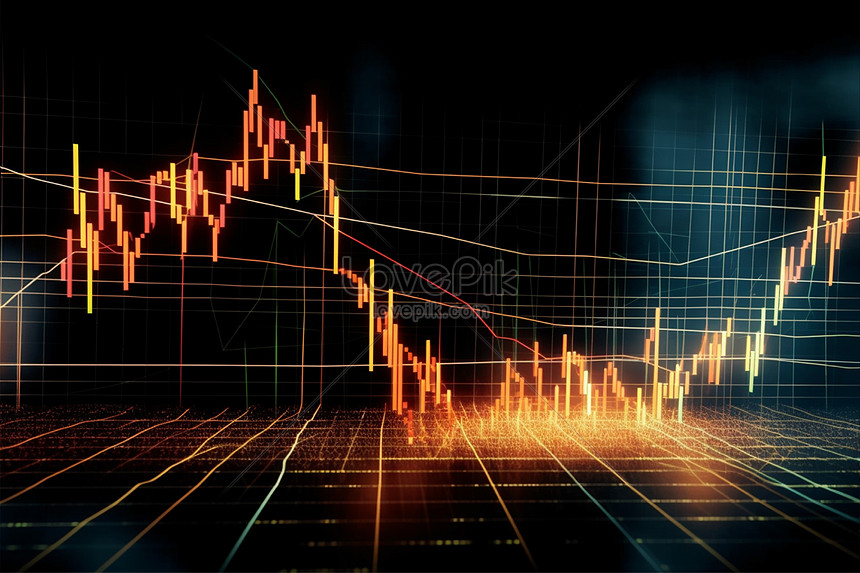
Nifty Trade Setup
The Nifty 50 ended marginally lower after experiencing volatility and closed just below the 200-day EMA (Exponential Moving Average) at 23,542 on November 14, extending its southward journey for the sixth consecutive session. However, for the week, the index was down by 2.55 percent. Considering the bearish sentiment, if the index decisively slips below the 200-day EMA, 23,200 (which coincides with the 50-week EMA) is the next level to watch. In case of a rebound, the index may face resistance in the 23,600–23,800 zone, experts said.
Here are 15 data points we have collated to help you spot profitable trades:
1) Key Levels For The Nifty 50 (23,533)
Resistance based on pivot points: 23,638, 23,683, and 23,756
Support based on pivot points: 23,491, 23,446, and 23,373
Special Formation: The Nifty 50 formed a Gravestone Doji candlestick pattern on the daily charts, continuing the formation of lower highs and lower lows, with a negative bias in momentum indicators such as the MACD (Moving Average Convergence Divergence) and RSI (Relative Strength Index), signaling a bearish sentiment. The index is now trading below all key moving averages. For the week, it formed a long red candle on the weekly timeframe.
2) Key Levels For The Bank Nifty
Resistance based on pivot points: 50,465, 50,612, and 50,849
Support based on pivot points: 49,989, 49,842, and 49,605
Resistance based on Fibonacci retracement: 50,980, 51,651
Support based on Fibonacci retracement: 49,273, 47,877
Special Formation: The Bank Nifty formed an Inverted Hammer candlestick pattern (though not a classical one), which is a bullish reversal pattern. It defended the 200-day EMA on a closing basis, as well as the previous day's low, although it traded well below all other key moving averages (10, 20, 50, and 100 EMAs). It was up 0.2 percent on Friday, but for the week, the index was down by 2.7 percent and closed below its upward-sloping support trendline, forming a long bearish candlestick pattern on the weekly timeframe. It is also trading in the lower band of the Bollinger Bands, which is a negative sign. Hence, consolidation cannot be ruled out.
3) Nifty Call Options Data
According to the weekly options data, the maximum Call open interest was seen at the 23,600 strike (with 1.04 crore contracts). This level can act as a key resistance level for the Nifty in the short term. It was followed by the 24,200 strike (85.13 lakh contracts), and the 24,000 strike (76.34 lakh contracts).
Maximum Call writing was observed at the 23,600 strike, which saw an addition of 71.23 lakh contracts, followed by the 23,500 and 23,700 strikes, which added 50.55 lakh and 15.2 lakh contracts, respectively. The maximum Call unwinding was seen at the 24,000 strike, which shed 30.64 lakh contracts, followed by the 24,500 and 23,800 strikes which shed 27.35 lakh, and 23.96 lakh contracts, respectively.
4) Nifty Put Options Data
On the Put side, the 23,500 strike holds the maximum open interest (with 2.6 crore contracts), which can act as a key support level for the Nifty. It was followed by the 23,000 strike (76.58 lakh contracts), and the 23,400 strike (62.65 lakh contracts).
The maximum Put writing was placed at the 23,500 strike, which saw an addition of 2.14 crore contracts, followed by the 23,400, and 23,100 strikes, with 31.28 lakh, and 22.11 lakh contracts added, respectively, while the maximum Put unwinding was seen at the 22,500 strike, which shed 22.15 lakh contracts, followed by the 22,300 and 23,700 strikes which shed 21.18 lakh and 17.94 lakh contracts, respectively.
5) Bank Nifty Call Options Data
According to the monthly options data, the maximum Call open interest was seen at the 52,000 strike, with 17.86 lakh contracts. This can act as a key resistance level for the index in the short term. It was followed by the 51,000 strike (14.41 lakh contracts) and the 51,500 strike (13.89 lakh contracts).
Maximum Call writing was visible at the 51,700 strike (with the addition of 8.56 lakh contracts), followed by the 51,000 strike (4.85 lakh contracts) and the 50,500 strike (4.04 lakh contracts), while there was hardly any Call unwinding seen.
6) Bank Nifty Put Options Data
On the Put side, the 49,500 strike holds the maximum open interest (with 18.04 lakh contracts), which can act as a key support level for the index. This was followed by the 50,000 strike (14.66 lakh contracts) and the 49,000 strike (10.62 lakh contracts).
The maximum Put writing was observed at the 50,500 strike (which added 2.23 lakh contracts), followed by the 50,200 strike (2.12 lakh contracts) and the 49,500 strike (2.04 lakh contracts), while the maximum Put unwinding was seen at the 49,000 strike, which shed 1.08 lakh contracts, followed by the 52,000 and 51,500 strikes, which shed 32,820 and 24,765 contracts, respectively.
7) Funds Flow (Rs crore)

8) Put-Call Ratio
The Nifty Put-Call ratio (PCR), which indicates the mood of the market, jumped to 0.88 on November 14, from the 0.70 level in the previous session.
The increasing PCR, or being higher than 0.7 or surpassing 1, means traders are selling more Put options than Call options, which generally indicates the firming up of a bullish sentiment in the market. If the ratio falls below 0.7 or moves towards 0.5, then it indicates selling in Calls is higher than selling in Puts, reflecting a bearish mood in the market.
9) India VIX
Volatility declined after the rally seen in the previous couple of days, but the higher levels of volatility signal caution for bulls. The India VIX (the fear index) fell by 4.28 percent to 14.78, down from 15.44.
10) Long Build-up (38 Stocks)
A long build-up was seen in 38 stocks. An increase in open interest (OI) and price indicates a build-up of long positions.
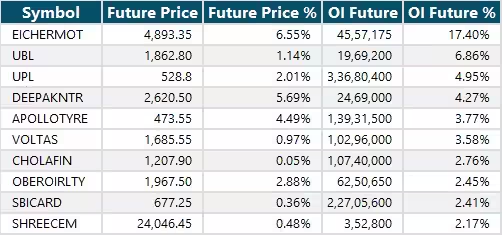
11) Long Unwinding (44 Stocks)
44 stocks saw a decline in open interest (OI) along with a fall in price, indicating long unwinding.
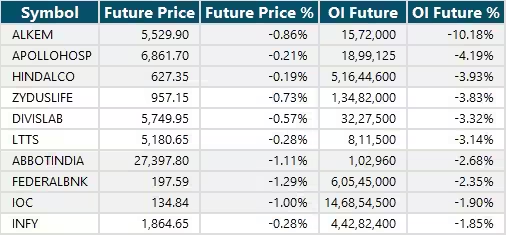
12) Short Build-up (45 Stocks)
45 stocks saw an increase in OI along with a fall in price, indicating a build-up of short positions.
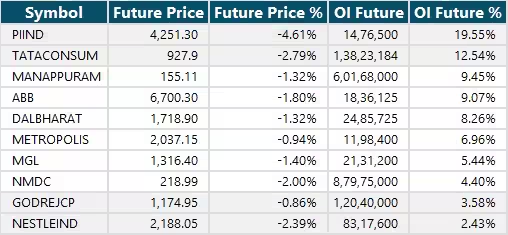
13) Short-Covering (54 Stocks)
54 stocks saw short-covering, meaning a decrease in OI, along with a price increase.
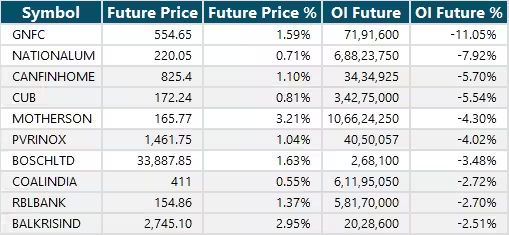
14) High Delivery Trades
Here are the stocks that saw a high share of delivery trades. A high share of delivery reflects investing (as opposed to trading) interest in a stock.

15) Stocks Under F&O Ban
Securities banned under the F&O segment include companies where derivative contracts cross 95 percent of the market-wide position limit.
Stocks added to F&O ban: Nil
Stocks retained in F&O ban: Aarti Industries, Aditya Birla Fashion & Retail, GNFC, Granules India, Hindustan Copper
Stocks removed from F&O ban: Nil
0 Comment